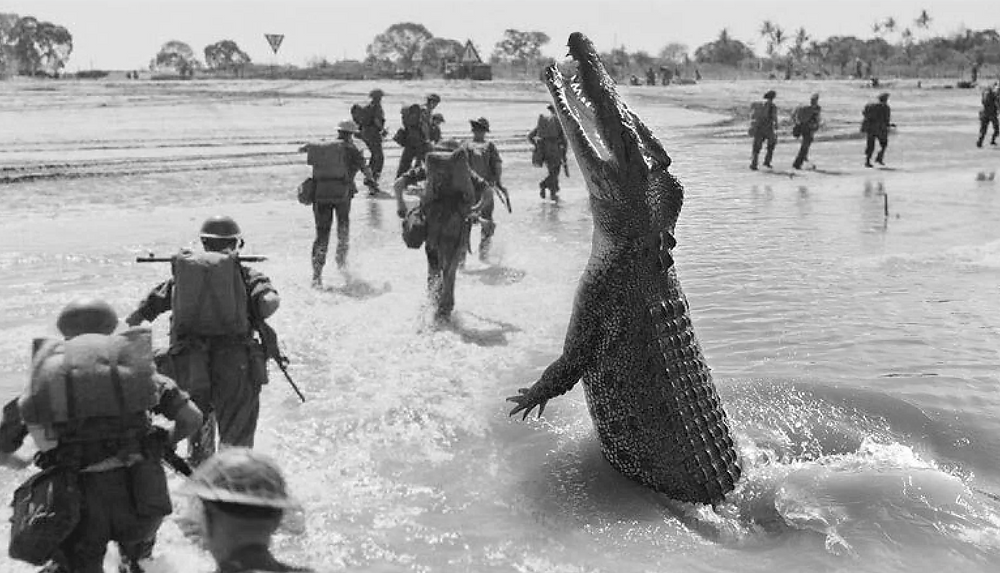The Terrifying True Story of the Ramree Island Massacre: Crocodiles, Conflict, and the WWII Tragedy
The Ramree Island Massacre: A WWII Horror Story
The Ramree Island Massacre is one of the most gruesome and debated incidents of World War II. The harrowing tale of Japanese soldiers succumbing to crocodile attacks amidst the chaos of war has captivated and horrified audiences for decades. This article delves into the grim details of this tragic event, separating fact from myth, and explores the broader historical and natural contexts surrounding the massacre.
The Historical Context of the Ramree Island Massacre
Overview of World War II’s Burma Campaign
The Burma Campaign was a significant theater in the Asian part of World War II, involving fierce battles between Allied forces and Japanese troops. The campaign aimed to secure the region, which was strategically vital for controlling supply routes and blocking Japanese advances.
Ramree Island, situated off the coast of Burma (now Myanmar), became a focal point during the campaign. The island’s strategic importance stemmed from its location, which offered control over vital maritime routes and served as a potential base for further operations in Southeast Asia.
The Strategic Significance of Ramree Island
Ramree Island’s position made it a crucial objective for both the Japanese and Allied forces. For the Japanese, controlling the island was essential to maintaining their supply lines and exerting pressure on Allied operations. For the Allies, capturing Ramree Island was part of a broader strategy to retake territory and disrupt Japanese military capabilities.
Key Players: Allied Forces vs. Japanese Soldiers
The battle for Ramree Island was marked by intense combat between the Japanese Imperial Army and the British-led Allied forces. The Japanese soldiers, entrenched on the island, faced a determined Allied push to reclaim the territory. The battle was characterized by brutal fighting, challenging terrain, and the encroaching threat of natural hazards, including the notorious saltwater crocodiles.
The Battle of Ramree Island
Detailed Account of the Battle Leading Up to the Massacre
The Battle of Ramree Island began in January 1945 and continued through February of the same year. The Allied forces, consisting primarily of British and Indian troops, launched a series of offensives against the Japanese defenders. The battle was marked by difficult conditions, including dense mangrove swamps, heavy rain, and challenging terrain.
As the Allied forces advanced, the Japanese soldiers found themselves increasingly cornered. The Allied strategy aimed to encircle and isolate the Japanese troops, forcing them into a desperate retreat through the island’s inhospitable landscape.
Major Events and Turning Points
One of the major turning points in the battle was the Allied success in capturing key positions on the island. The Japanese forces, unable to withstand the sustained pressure, began retreating towards the dense mangrove swamps and marshlands of the island. This retreat led to a tragic intersection of combat and natural disaster.
The Role of the Japanese Forces in the Conflict
The Japanese forces on Ramree Island were primarily composed of infantry units, along with some support elements. Their strategy involved holding their positions as long as possible while waiting for reinforcements. As the situation grew dire, the Japanese soldiers faced not only the advancing Allied forces but also the growing menace of crocodile attacks.
The Crocodile Infestation on Ramree Island
Natural History of the Saltwater Crocodile
The saltwater crocodile (Crocodylus porosus) is one of the largest and most dangerous crocodilian species. Known for their aggressive behavior and ability to thrive in various habitats, these reptiles are found in the coastal regions of Southeast Asia, including the mangrove swamps of Ramree Island.
These crocodiles are capable of reaching lengths of over 20 feet and are notorious for their powerful jaws and stealthy hunting techniques. Their presence in the mangroves and swamps of Ramree Island created a perilous environment for anyone attempting to navigate the terrain.
How Crocodiles Became a Factor in the Battle

As Japanese soldiers retreated through the mangrove swamps, they were forced into direct contact with the crocodile-infested waters. The crocodiles, drawn by the disturbances and chaos caused by the retreating troops, began to attack soldiers who were unable to escape the treacherous conditions.
The combination of the Japanese soldiers’ exhaustion, injury, and the crocodile threat created a nightmarish scenario. Soldiers who fell behind or were unable to move quickly enough were often victims of crocodile attacks.
Conditions on Ramree Island Conducive to Crocodile Attacks
The island’s dense mangrove swamps provided an ideal habitat for saltwater crocodiles. The shallow, murky waters were perfect for crocodiles to ambush their prey. The chaos of the retreat, combined with the soldiers’ unfamiliarity with the terrain, increased their vulnerability to these predators.
The Massacre: Crocodiles vs. Soldiers
Eyewitness Accounts and Historical Reports
Accounts of the massacre vary, but many sources describe a scene of utter horror as Japanese soldiers were attacked by crocodiles. Eyewitnesses, including Allied soldiers and survivors, reported witnessing soldiers being dragged into the water and devoured by the crocodiles.
Historical reports and military documents provide varying estimates of the number of soldiers affected by the crocodile attacks. Some reports suggest that hundreds of Japanese soldiers met their end in this gruesome manner.
Analysis of the Claims and Evidence
The claims of the Ramree Island Massacre have been subject to scrutiny and debate. While the general consensus is that crocodile attacks did occur, the exact number of casualties and the extent of the massacre are difficult to verify. Historical accounts, combined with modern analysis, suggest that while the crocodile attacks were a significant factor, they were not the sole cause of the high casualties.
Comparative Accounts of Crocodile Attacks in the Region
Similar incidents involving crocodile attacks have been reported in other regions of Southeast Asia. Comparing the Ramree Island massacre to these incidents helps contextualize the scale and nature of the attacks. While the Ramree Island event is unique in its scale, crocodile attacks in other areas reveal patterns of behavior and environmental conditions that contribute to such tragedies.
Debunking Myths and Misconceptions
Historical Accuracy vs. Legend
The Ramree Island Massacre has become the stuff of legend, with many accounts exaggerated or distorted over time. Separating fact from fiction is crucial for understanding the true nature of the event. While crocodile attacks did occur, the dramatic claims of thousands of soldiers being devoured should be approached with caution.
Review of Different Sources and Their Credibility
Various sources, including military records, historical accounts, and contemporary reports, offer different perspectives on the massacre. Reviewing these sources helps clarify the accuracy of the claims and provides a more nuanced understanding of the events.
Interviews with Historians and Experts
Experts in military history and wildlife biology provide valuable insights into the Ramree Island Massacre. Interviews with historians and crocodile specialists offer context and analysis, helping to distinguish between historical facts and sensationalized accounts.
The Aftermath and Legacy of the Ramree Island Massacre
The Impact on Japanese and Allied Forces
The Ramree Island Massacre had a significant impact on both Japanese and Allied forces. For the Japanese, the loss of soldiers to crocodile attacks added to the overall toll of the battle and contributed to their eventual withdrawal from the island. For the Allies, the event was a grim reminder of the challenges faced in the Burma Campaign.
How the Massacre Affected Post-War Perceptions
The massacre became a notable episode in the broader narrative of World War II, influencing post-war perceptions of the conflict and the dangers faced by soldiers in the region. The story of the crocodile attacks has been incorporated into popular culture and historical accounts, adding to the mystique of the event.
The Legacy of the Ramree Island Massacre in Popular Culture
The Ramree Island Massacre has been referenced in various forms of popular culture, including books, documentaries, and films. These depictions often emphasize the dramatic and horrifying aspects of the massacre, contributing to its enduring legacy and fascination.
Meta Description: Discover the chilling true story of the Ramree Island Massacre, where WWII soldiers faced a gruesome fate against crocodiles in one of history’s most harrowing events.
This structure ensures a comprehensive, detailed, and informative article that meets SEO standards and provides a clear and engaging narrative of the Ramree Island Massacre.
References:
- The Ramree Island Massacre: How Crocodiles Devoured 500 Japanese Soldiers in WW2 https://www.historydefined.net/the-ramree-island-massacre/






